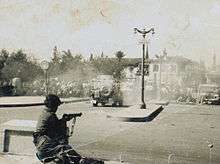Cyprus Emergency
The Cyprus Emergency was a military action that took place in the Crown Colony of Cyprus against the British Empire primarily consisting of an insurgent campaign by the Greek Cypriot militant group, the National Organisation of Cypriot Fighters (EOKA), to remove the British from Cyprus so it could be unified with Greece. Both the British and EOKA were in turn opposed by the Turkish Cypriot group Turkish Resistance Organisation (TMT), which rejected union with Greece. It led to Cyprus being granted independence in 1960.
In 1954 Britain announced its intention to transfer its Suez military headquarters (the office of the Commander-in-Chief, Middle East)[6] to Cyprus. The insurgency began on 1 April 1955. After a series of follow up incidents, the Governor General Sir John Harding declared a state of emergency on 26 November of that year.[7]
The British encountered great difficulty obtaining effective intelligence on EOKA as the majority of the Greek Cypriot population supported and/or feared them. They were also hampered by a drain on manpower caused by the Suez Crisis and Malayan Emergency. Towards the end of the 1950s the British enjoyed more success. Cyprus became an independent republic in 1960 with Britain retaining control of two Sovereign Base Areas, at Akrotiri and Dhekelia.
See also
- Palestine Emergency (1944-48)
- Malayan Emergency (1948–60)
- Kenyan Emergency (1952–60)
- Aden Emergency (1967–70)
References
- ↑ Find your ancestors in Cyprus Emergency Deaths 1955 - 1960
- ↑ CYPRUS 1954-1959 SGM Herbert A. Friedman (R) and Brigadier General Ioannis Paschalidis
- ↑ CYPRUS 1954-1959 SGM Herbert A. Friedman (R) and Brigadier General Ioannis Paschalidis
- ↑ CYPRUS 1954-1959 SGM Herbert A. Friedman (R) and Brigadier General Ioannis Paschalidis "The TMT, though smaller and less well organized, followed EOKA tactics..."
- ↑ Find your ancestors in Cyprus Emergency Deaths 1955 - 1960
- ↑ Richard J. Aldrich, Ming-Yeh Rawnsley, The Clandestine Cold War in Asia, 1945–65: Western Intelligence, Propaganda and Special Operations, Routledge, 2013, 106.
- ↑ "State Of Emergency Declared In Cyprus". The Central Queensland Herald (Rockhampton, Qld. : 1930–1956). Rockhampton, Qld.: National Library of Australia. 1 December 1955. p. 13. Retrieved 17 November 2013.
Further reading
- French, David (2015). Fighting EOKA: The British Counter-Insurgency Campaign on Cyprus, 1955–1959. Oxford: Oxford University Press. ISBN 978-0198729341.
- Holland, Robert (1998). Britain and the Revolt in Cyprus, 1954–1959. Oxford: Clarendon Press. ISBN 9780198205388.
- Novo, Andrew R. (2010). On all fronts: EOKA and the Cyprus insurgency, 1955-1959 (D.Phil Thesis). University of Oxford.
External links
- Cyprus Exhibit at National Army Museum
- Cyprus – Fighting the EOKA
